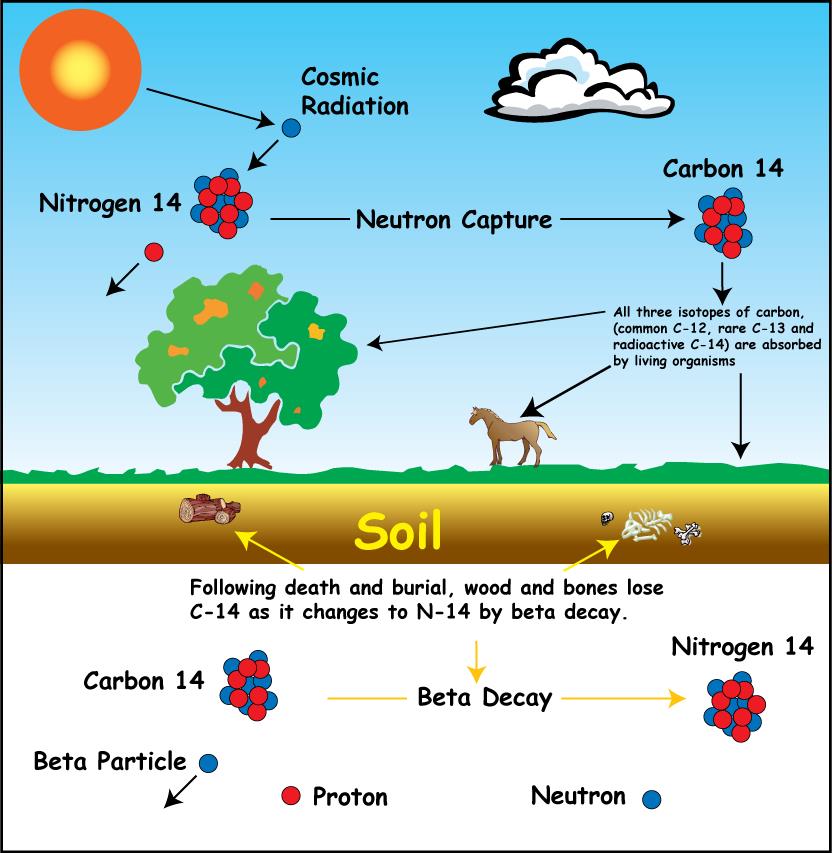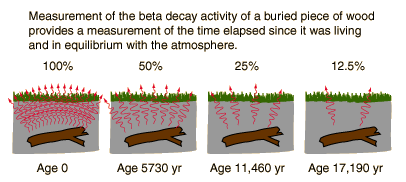- Navigation menu
- How Does Radiocarbon-14 Dating Work?
- Radiometric dating - Wikipedia
- What is Radiocarbon Dating?
- Radiocarbon dating
Which means you get no protons, no neutrons, no electrons, no atoms. We see a relic of a tremendously hot surface, the Cosmic Microwave Background.
Navigation menu
Not only that, but the CMB is everywhere, so everywhere was once emitting the CMB at a phenomenal temperature a very long time ago. The CMB is normal photons, which means neither the weak force nor the electromagnetic force were any different in magnitude or sign that far back all across the universe. If they were, we wouldn't have had photons. We do have photons, hence they were not.
The weak force has not changed during the history of the solar system. Actually, the first answer is also "yes" - until "effected" becomes "affected" quote: More precisely, we can put limits on how much it could have changed - and it's pretty damn small. Sadly not, or at the very least, facing an utter lack of supporting evidence. Electron capture is a much more viable hypothesis than fudging around with a fundamental force. Originally posted by bantha: This surface is what we see in the cosmic microwave background Hat mentioned earlier, and reconciles quite well with current particle theory without altering the electroweak force.
How Does Radiocarbon-14 Dating Work?
The change could be trailing or preceding our ability to detect it in every case, due to the very same reason we are able to "look into the past" in the first place I don't think this works. We would have opportunities to detect it in various ways. For one thing, there are a very small number of blue shifted entities entities that are coming toward us instead of going away that should be a problem for such a hypothesis. Relativity probably also creates problems for it in a similar fashion. As it stands, the thesis is vulnerable to being shown, in some fashion of this sort, to be a privileged frame of reference argument.
That is, treating our location as having magical properties. As you state it, not quite so, but I think there's enough going on and we can observe enough directionality in the universe that we'd see some pretty strong hints if constants varied in that fashion. Additionally, not every particle existed at the big bang. They can be created and destroyed yet preserving the conservation laws.
How do they know, then, what time it is and how to be properly elongated?
- dating in illinois;
- dating dwts.
- Carbon dating, rate of decay, how far can we go? - Ars Technica OpenForum.
In what frame of reference are they to be elongated? Towards us only privileged frame problems or toward some other body with a different relativistic velocity in another direction? How can it have different elongations of the constants towards different bodies?
Physics major, but in the end, I don't think this works. Or, if it does, it will take the next Einstein to explain it. I suppose this is only tangentially related, but it's a question I've been thinking about for a while now, and I don't think it's worth its own thread.
I think the place to look for evidence for that the cosmic background radiation is differentiated in some way. But, while space is largely empty, not all of it is. There's patches where it isn't so empty, just by sheer chance and volume of the universe. I think you also need to play Einstein and create some equations. While they are hard to detect precisely because they are so energetic, cosmic rays that come through the sun versus from outside the solar system that is, a place where no planets are, especially Jupiter should show, on whatever equations you posit, some sort of difference.
Or, if that creates problems due to the known issues around photons and gravity, some other near-solar incident angle that's far enough away to create the problem in an easily measured way. Versus, of course, nowhere near the sun. Maybe X Rays or other wavelengths would work as well. Gravitational lenses may be useful here although in this case, it would be measuring only "half" of the lensing versus something a bit "farther to the left".
I suspect we'd know about it if that sort of thing was true.
- goth dating tips!
- what age should you start dating as a christian;
- Carbon dating, rate of decay, how far can we go??
- History of Radiocarbon-14 Dating.
- How reliable is radiocarbon dating?.
- dating communication.
- How Does Carbon Dating Work.
Astronomers do look in pretty much every direction and pretty much every wavelength we can even occasionally detect. Unless everyone was asleep possible, I suppose -- we don't always look for what we don't expect , then there'd already be people talking about the problem, perhaps trying to attribute it to gravity which is an issue, even for photons or something of the sort. Originally posted by Control Group: If that were the case, we'd see lensing effects dramatically different than what we do see. Observable gravitational lensing pretty much agrees with relativity.
You would need to give mass some kind of property that changes c. Let's say we do. Gravitational lensing is nothing like how we observe it. If c is faster away from the immediate vicinity of mass, we see less lensing. If c is slower away from the immediate vicinity of mass, we see more lensing. Objects do not follow the laws of motion anymore. We see objects either ahead if faster c or behind if slower c where they should be after accounting for the constant speed of light.
General Relativity doesn't work, ever, for anything. GR is based entirely around the immutable assertion of c being constant in all frames of reference. If that's not true, GR doesn't work. Doppler shifting goes crazy. If light slows down it shifts slightly to a higher frequency shorter wavelength to maintain the amount of energy it has.
Radiometric dating - Wikipedia
This is mandated by thermodynamics. If light speeds up, it shifts to a longer wavelength. The energy in the velocity as light has momentum has to come from somewhere or go to somewhere.

That somewhere is in the electromagnetic field of the photon. We don't see any of that. Black holes would behave VERY differently. When slowed or accelerated, the lines added would be shifted.
What is Radiocarbon Dating?
Light magically doubles in speed away from any mass. We detect light from a distant galaxy cluster carrying the absorption line at We detect the hydrogen line shifted far into UV, yet the rest of the spectrum is redshifted from the galaxy cluster. To date older objects, you need to use different radioisotopes.
For dating stuff that's millions of years old, you use K and Ar. As Hat and the others have explained far better than I ever could, decay rates can't have changed appreciably over the history of the universe, otherwise the very nature of matter would have changed in that time, which would be noticeable as we look farther out. Electron capture can affect the decay rates of certain isotopes appreciably IINM, but that's not a change in the "constant" behind radioactive decay.
They've just announced a big improvement in the precision of argon-argon dating. A physicist acquaintance corrected me on this about 35 years ago, as will be evident shortly , saying it's true for Special Relativity, but not GR. The two principles of GR are equivalence and relativity. Relativity is that the laws of physics are immutable over space and time. You mean like this? It's not definite yet, but it's starting to seem likely that the fine structure constant is not, in fact, constant and possibly as a result, and I can't emphasize the word possibly strongly enough, the speed of light is not constant either.
Now the variations aren't large enough on the relevant time scale to effect any radiological dating systems we currently use. Still, the assumption that the physical "constants" of the universe have always been that way is just that, an assumption, and one that is starting to look less likely to be true. Originally posted by shread: You may have misunderstood your physicist friend.
GR expands the scope of what reference frames are valid, but still requires the speed of light to be invariant between valid reference frames. Essentially reference frames that are in free fall are valid. The equivalence principle you mentioned is meant to generalize special relativity to reference frames undergoing gravitational acceleration. Carbon dating, rate of decay, how far can we go? Ars Legatus Legionis et Subscriptor. While the lighter isotopes 12 C and 13 C are stable, the heaviest isotope 14 C radiocarbon is radioactive.
This means its nucleus is so large that it is unstable. Over time 14 C decays to nitrogen 14 N. Most 14 C is produced in the upper atmosphere where neutrons, which are produced by cosmic rays , react with 14 N atoms. This CO 2 is used in photosynthesis by plants, and from here is passed through the food chain see figure 1, below.
Every plant and animal in this chain including us!
Radiocarbon dating
When living things die, tissue is no longer being replaced and the radioactive decay of 14 C becomes apparent. Around 55, years later, so much 14 C has decayed that what remains can no longer be measured. In 5, years half of the 14 C in a sample will decay see figure 1, below. Therefore, if we know the 14 C: Unfortunately, neither are straightforward to determine. The amount of 14 C in the atmosphere, and therefore in plants and animals, has not always been constant. For instance, the amount varies according to how many cosmic rays reach Earth. Luckily, we can measure these fluctuations in samples that are dated by other methods.
Tree rings can be counted and their radiocarbon content measured.
